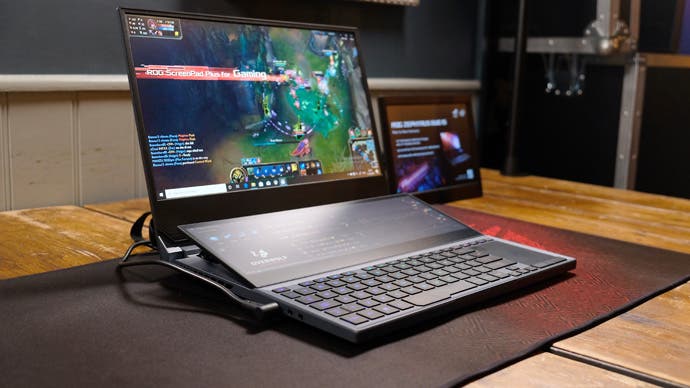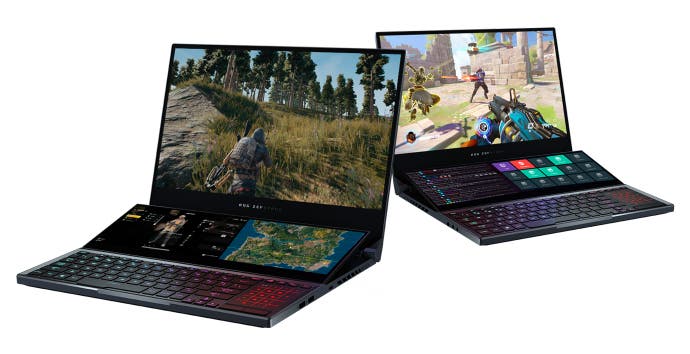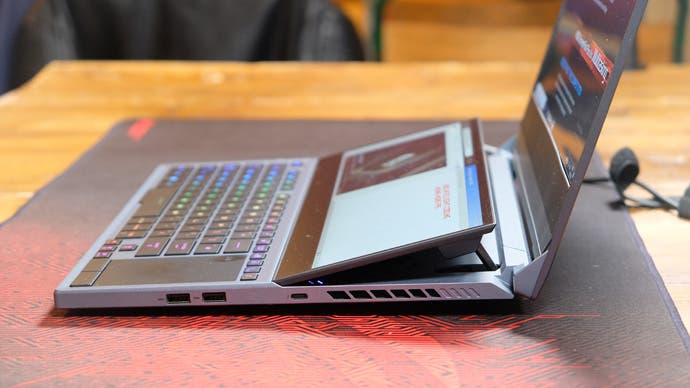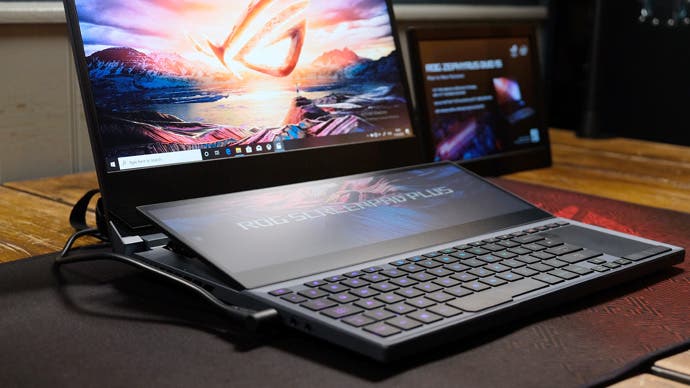Hands-on with the dual-screen, ultra-premium Asus ROG Zephyrus Duo 15
With 10th-gen Comet Lake H processors and RTX Super graphics.
The first laptops with Intel Comet Lake H processors and Nvidia RTX Super graphics cards are on the way soon, and we've already gone hands on with a few of them thanks to a recent Asus press event. The star of the show there was the ROG Zephyrus Duo 15, a hyper-modern machine that is the best argument for dual-screen laptops we've seen to date.
Like the Asus Zenbook Pro Duo, a dual-screen laptop released last year, the laptop's 14-inch secondary display sits beneath the main 15-inch screen, offering about the same width and nearly half the height with a resolution of 3840x1100. Unlike that machine though, the secondary screen automatically angles upwards as the lid of the laptop is opened, ensuring that you're not looking at the screen off-axis and allowing a 28.5mm air intake to be exposed.

The mechanism here is robust too; the touch screen didn't shift a millimetre under even the harshest of taps and worked silently even on the pre-production machine we had access to. The transformation is fascinating to watch, the sort of thing you'll want to do just for the joy of it, and that's a rarity on laptops these days.
As pleasant as it is, that perfectly positioned secondary screen also feels very practical. It's easy to envisage a multitude of uses for the secondary touch display, from toolbars in Photoshop or Premiere Pro to map and inventory screens in battle royale games. Of course, most games aren't built to take advantage of this extra real estate, with only Dying Light 2 listed as being compatible at present, but Asus is working with Overwolf to display in-game stats on the second screen in games like Rainbow Six Siege, Counter-Strike and League of Legends.
As well as treating the laptop as having one extra-tall screen, with programs spanning both physical displays, you can also run entirely separate programs there. For example, if you were streaming, you could have your game screen on the primary display, then use the half-height display to read chat and see a small preview window. If you have tried a dual-monitor or ultra-wide setup on your desktop PC, then you'll know just how transformative some extra screen real estate can be.

Creators have flocked to the few dual-screen laptops that have arrived at retail, citing the productivity benefits, and I'd expect a similar reaction to the Zephyrus Duo 15 if Asus' software is up to the task. Our time actually using the screen was limited, but it was highly readable with good viewing angles and vibrant colours - although the reflections evident in our photos suggest it might not be the best performer outside. The keyboard also impressed, a comfortable 1.4mm of travel, n-key rollover and per-key RGB backlighting, but the touchpad on the right side of the laptop is probably best kept in its numpad mode so you can use a regular wired or wireless mouse.
While that second screen is undoubtedly the highlight here, the main screen is also pretty impressive in its own right, with two configurations suited for each of this machine's target markets. There's a 300Hz 1080p IPS panel designed to offer an extremely responsive experience for gamers, although you'll have to stick to esports titles like Counter-Strike or Valorant to run at such a high frame-rate consistently. There's also a more creator-focused option, a 4K 60Hz IPS panel that covers 100 per cent of the Adobe RGB colour gamut. Both screens are factory calibrated and support full-fat G-Sync, neither of which are givens - even on extremely high-end laptops.

While its modern dual-screen design sets it apart, the Duo 15 also impresses with its high-end spec sheet. You can get one with a 10th-gen Core i9 Comet Lake H CPU, an eight-core, sixteen-thread part that can boost up to 5.3GHz - a higher frequency than even Intel's Core i9 9900K desktop processor. This level of processing horsepower should allow the laptop to handle both gaming and content creation tasks with aplomb, especially as Asus have paired it with Thermal Grizzly liquid metal instead of a more traditional low-cost thermal compound. That should allow for significantly lower temperatures at a given voltage, which in turn should unlock higher sustained performance. The liquid metal is actually something that Asus are rolling out to all of their laptops based around 10th-gen Intel processors, which is great to see as most users won't be comfortable with opening up their notebooks and applying it themselves.
Graphics are handled by an RTX 2080 Super graphics card in the highest-end model, which should be capable of running even modern games at 4K, with 3072 CUDA cores and 8GB of GDDR6 video memory. This graphics card also unlocks support for important next-generation features like hardware-accelerated ray tracing and DLSS. (Unfortunately, we weren't able to run any benchmarks or games on the pre-production machine to analyse the machine's actual performance - such is the nature of these carefully monitored press events.) This potent CPU/GPU is backed by up to 32GB of RAM running at 3200MHz and twin 1TB NVMe SSDs in RAID0, which ought to remove potential bottlenecks from gaming and content creation workloads alike.

Of course, with this level of power you'd expect some sacrifices. Surprisingly, size and weight aren't among them, with Asus reporting the magnesium-aluminide laptop measures 21mm thick and weighs 2.4 kilograms - not an ultra-portable machine by any means, but hardly a hulking desktop replacement either. The Duo 15 has a good level of connectivity as well, with Wi-Fi 6 and Bluetooth 5, plus USB 3.2 Gen 2 Type-C with Thunderbolt 3, HDMI 2.0b, three USB-A ports, two 3.5mm ports and gigabit ethernet. Two of the USB-A ports are awkwardly placed, sitting right where you'd likely place your mouse if you're right-handed, but otherwise there's little to complain about here.
Battery life should also be acceptable, with a 90Wh internal battery, but without a quoted endurance figure we'd guess that the Zephyrus Duo 15 is largely intended to be used plugged in. You can at least charge the unit via a traditional 240W power brick or via 65W USB-C Power Delivery, with the latter option providing enough juice for light tasks but not full-strength gaming or video encoding.

OK, let's address the elephant in the room. Yes, this is a supremely expensive laptop, with a starting price of £2999. That's for a model with a Core i7 10875H processor, RTX 2070 Super graphics card and 1TB of storage, and Asus haven't even listed a price for the model we went hands-on with, which has that top-grade Core i9 10980HK processor, RTX 2080 Super graphics card and 2TB of storage. That exceedingly high price means that the Zephyrus Duo 15 isn't a laptop we actually recommend buying for 99.9 per cent of the population when it comes out in July, but this machine certainly remains a technological marvel - with a perfectly positioned second screen and bleeding edge specifications packed into a surprisingly slim chassis.
There are lots of great ideas here for Asus - and indeed its competitors - to innovate on, and I hope that will mean that we eventually see a half-way affordable laptop with a similar form factor in a few years time. For now though, the Zephyrus Duo 15 is a stunning halo product from Asus and an exciting glimpse into the future of dual-screen laptop designs.

